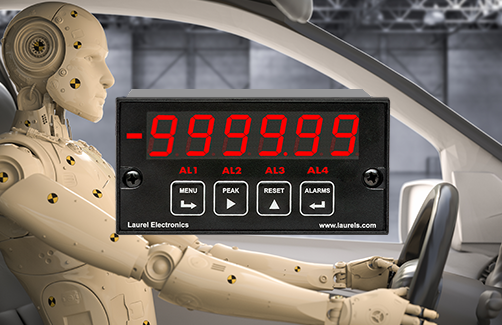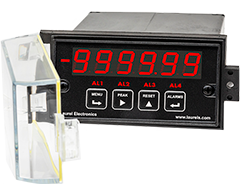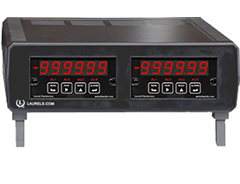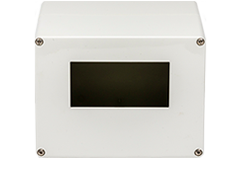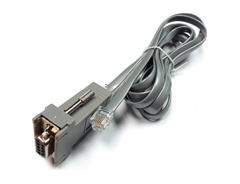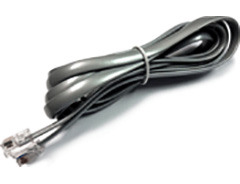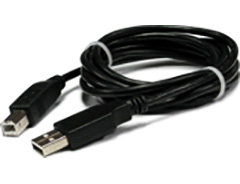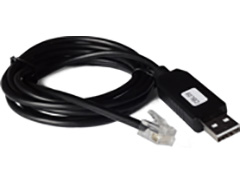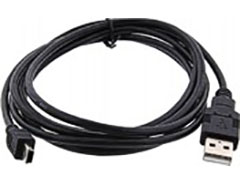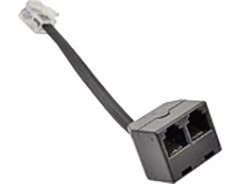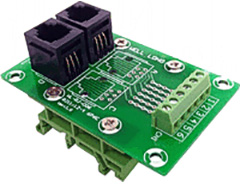Features
- Times single or cumulative events from 1 µs to 999,999 hrs
- Transmits single event time or accumulated time of all events
- Timing resolution to 0.2 µs
- Timing from 0.2 µs to 999,999 hrs
- Selectable HH.MM.SS clock format or 6-digit H, M or S decimal format
- Inputs from NPN or PNP proximity switches, contact closures, digital logic, magnetic pickups down to 12 mV, or AC inputs up to 250 Vac
- Triggers on positive or negative pulse edges
- Digital span adjust from 0 to ±999,999, zero adjust from -999,999 to +999,999
- Front panel scalable: to ±999,999 for use with current shunts
- 1/8 DIN size with bright red or green 0.56" (14.2mm), high LED digits
- Transducer excitation output, 5, 10, 12, or 24 Vdc (isolated)
- Power 85-264 Vac / 90-300 Vdc or 10-48 Vdc / 12-32 Vac (isolated)
- Operating temperature from -40°C to 70°C (-40°F to 158°F)
- Wide choice of Plug-in-Play options:
- 2 or 4 relays, mechanical or solid state, for alarm or control (isolated)
- 1 or 2 Analog output, 4-20 mA, 0-20 mA, 0-10V, or -10V to +10V (isolated)
- Communications: Ethernet, WiFi, USB, RS232, RS485 (isolated)
- Extended DPM includes rate and total simultaneously, dynamic up-down counting, arithmetic functions

The Laureate™ 1/8 DIN Digital Panel Meter, 6-digit digital stopwatch and timer
can record single or cumulative events ranging from 1 µs to 999,999 hours, with a timing resolution as precise as 0.2 µs. It offers selectable time display formats in HH:MM:SS or 6-digit H, M, or S decimal format, accommodating a variety of measurement needs. Compatible with inputs from NPN or PNP proximity switches, contact closures, digital logic, magnetic pickups as low as 12 mV, and AC inputs up to 250 Vac, it triggers on both positive and negative pulse edges. The device operates on a broad power range of 85-264 Vac / 90-300 Vdc or 10-48 Vdc / 12-32 Vac with (isolated) transducer excitation output. It functions reliably in temperatures from -40°C to 70°C. Additionally, it offers a wide range of options including 2 or 4 relays (mechanical or solid-state, (isolated)), 1 or 2 analog outputs (isolated), and various communication interfaces such as Ethernet, WiFi, USB, RS232, and RS485 (isolated).- A-A Stopwatch Mode. Time can be measured between a start pulse and a stop pulse, both on Channel A, from either the positive or negative edges.
- A-B Stopwatch Mode. Time can also be measured between a start pulse on Channel A (positive or negative edge) and a stop pulse on Channel B (positive or negative edge). This mode allows inputs from different sources. In addition, the A and B inputs can be tied together to start the stopwatch with one polarity and stop it with the other polarity.
- Rate Based on 1/Time Mode. Highly accurate rate can be displayed by taking the inverse of time. Extensive arithmetic capabilities allow display in engineering units, such as meter/sec. This mode requires use of an Extended counter.
Display. The event time (Item #1) may be displayed as a decimal number with six-digit resolution. The longest single-event timing interval is 999,999 hours. The highest resolution is 0.2 µs. The event time may also be displayed in HH.MM.SS clock format with 1 s resolution. The stopwatch display is updated during timing at a rate controlled by a gate time, up to 25/s. It is reset to zero when the next start pulse occurs. Accumulated time from multiple events (Item #2) is also tracked and may be displayed up to 999,999 hours.
The FR dual-channel signal conditioner board accepts inputs from proximity switches with a PNP or NPN output, TTL or CMOS logic, magnetic pickups, contact closures, and other signals from 12 mV to 250 Vac. Jumper selections provide optimum operation for different sensor types and noise conditions. A built-in (isolated) 5, 10, 12, or 24 Vdc excitation supply can power proximity switches and other sensors, and eliminate the need for an external power supply.
Extended DPM includes rate and total simultaneously, dynamic up-down counting, arithmetic functions applicable to channels A & B (A+B, A-B, A/B, AxB, A/B-1), phase angle, power factor, duty cycle, batch control, custom curve linearization.
Laureate Digital Panel Meters are easily programmed with Laurel’s free Instrument Setup Software, downloadable from our website and compatible with Windows PCs, requiring a data interface board for setup.
All signal conditioner board ranges are factory-calibrated, with calibration factors for each range securely stored in an onboard EEPROM. These factors can be scaled via software to accommodate external shunts, enabling field replacement of signal conditioner boards without necessitating recalibration of the associated digital panel meter. For optimal accuracy, factory recalibration is recommended annually. All Laurel Electronics instruments undergo factory calibration using the industry-leading Fluke calibrators, which are recalibrated yearly and certified traceable to national standards, ensuring the highest level of precision and reliability.
- An unfiltered selection provides true peak and valley readings and aids in control applications.
- A batch average filter selection averages each 16 conversions.
- An adaptive moving average filter selection provides a choice of 8 time constants from 80 ms to 9.6 seconds. When a significant change in signal level occurs, the filter adapts by briefly switching to the shortest time to follow the change, then reverts back to its selected time constant. An Auto setting selects the time constant selection based on signal noise.
Peak and valley values are automatically captured. These may be displayed via a front panel pushbutton command or control signal at the rear connector, or be transmitted as serial data.
Two rear panel control Inputs (CMOS/TTL levels, logic 0 = tied to digital ground, logic 1 = open) or dry contacts that can be set to control / activate 14 meter commands.
An (isolated) 5, 10, 12, or 24 Vdc excitation output is standard to power transducers or two-wire transmitters. Ratiometric operation, which automatically compensates for changes in the applied excitation, is jumper selectable for applications, such as bridges, where the signal to be measured is proportional to the excitation level.
Modular Design for Maximum Flexibility at Minimum Cost
All boards are isolated from meter and power grounds. Optional Plug-in-Play boards for communications and control include Ethernet, WiFi, serial communication boards, dual or quad relay boards, and an analog output board. Laureates may be powered from 85-264 Vac or optionally from 12-32 Vac or 10-48 Vdc. The display is available with bright red or green 0.56" (14.2mm) high LED digits. The 1/8 DIN case meets NEMA 4X (IP65) specifications from the front when panel mounted. Any setup functions and front panel keys can be locked out for simplified usage and security. A built-in 5, 10, 12, or 24 Vdc excitation supply can power transducers, eliminating the need for an external power supply. All power and signal connections are via UL / VDE / CSA rated screw clamp plugs.
The Laureate™ Series features modular design with up to 7 isolated plug-in boards, applicable to all Laureate 1/8 DIN Digital Panel Meters.

Modular Hardware
The design of the Laureate™ Series is modular for maximum flexibility at minimum cost. All boards are isolated from meter and power grounds. The base configuration for a panel meter or counter consists of a main module (with computer and plug-in display boards), a power supply board, and a signal conditioner board. Optional plug-in-play boards include an isolated setpoint controller board, an isolated analog output board, and an isolated digital interface board. Modular design and a choice of plug-in options allow the Laureate to be customized for a broad range of applications from simple monitoring to control and computer interface. There can be up to five plug-in boards in a 1/8 DIN Laureate.

Connecting Laureate Digital Panel Meters to a Local Area Network (LAN)
Up to 30 Laureate Digital Panel Meters and/or LT Transmitters can be configured for RS485 and daisy-chained to an LT Transmitter using Laurel’s High Speed Ethernet-to-RS485 converter board for seamless LAN integration. Alternatively, Laurel LTE series Ethernet transmitters can connect directly to a LAN via an Ethernet cable. Setup for both configurations is streamlined using Laurel’s free Instrument Setup Software, which simplifies node discovery and transmitter configuration.
Flexible Communication Options for Digital Panel Meters
Laureate Digital Panel Meters can be equipped with Laurel communication boards to support various interfaces and protocols. These include serial interfaces with ASCII or Modbus RTU protocols, and Ethernet interfaces with web access, ASCII, or Modbus TCP/IP protocols, ensuring versatile connectivity for your commercial applications.

| Display | |
|---|---|
| Readout | 5 LED digits, 7-segment, 14.2 mm (.56"), red or green. |
| Range | -999,999 to +999,999 |
| Indicators | Four LED lamps |
| Inputs | |
| Types | AC, pulses from NPN, PNP transistors, contact closures, magnetic pickups. |
| Grounding | Common ground for channels A & B |
| Minimum Signal | Nine ranges from (-12 to +12 mV) to (+1.25 to +2.1V). |
| Maximum Signal | 250 Vac |
| Noise Filter | 1 MHz, 30 kHz, 250 Hz (selectable) |
| Contact Debounce | 0, 3, 50 ms (selectable) |
| Recalibration: All ranges are calibrated at the factory. Recalibration is recommended every 12 months. | |
| Stopwatch Mode | |
| Timing Modes: | |
| With Ch A only | + to + edge, or - to - edge. |
| With Ch A tied to Ch B | + to - edge, or - to + edge. |
| With Ch A and Ch B | + edge of A to + edge of B, + edge of A to - edge of B, |
| - edge to A to - edge of B, - edge of A to - edge of B | |
| Timing Interval | 1 µs to 999,999 hrs |
| Timing Resolution | 0.2 µs to 1 hr |
| Selectable Decimal Time | 999999 H, M or S format with decimal point |
| Selectable Clock Time | HH.MM.SS format |
| Output & Display Update | 0 ms + programmable from 10 ms to 199.99 s |
| Accuracy | |
| Time Base | Crystal calibrated to ±2 ppm |
| Span Tempco | ±1 ppm/°C (typ) |
| Long-term Drift | ±5 ppm/year |
| Power Supply Boards (one required) | |
| Voltage, standard | 85-264 Vac or 90-300 Vdc |
| Voltage, optional | 12-32 Vac or 10-48 Vdc |
| Frequency | DC or 47-63 Hz |
| Power Isolation | 250V rms working, 2.3 kV rms per 1 min test |
| Excitation Output (standard) | |
| 5 Vdc | 5 Vdc ± 5%, 100 mA (jumper selectable) |
| 10 Vdc | 10 Vdc ± 5%, 120 mA (jumper selectable) |
| 12 Vdc | 12 Vdc ± 5%, 100 mA (jumper selectable) |
| 24 Vdc | 24 Vdc ± 5%, 50 mA (jumper selectable) |
| Output Isolation | 50 Vdc from signal ground |
| Analog Output Boards (one optional) | |
| Output levels | 4-20 mA, 0-20 mA, 0-10V, -10 to +10V (single-output option) |
| 4-20 mA, 0-20 mA, 0-10V (dual-output option) | |
| Current compliance | 2 mA at 10V ( > 5 kΩ load) |
| Voltage compliance | 12V at 20 mA (< 600 Ω load) |
| Scaling | Zero and full scale adjustable from -99999 to +99999 |
| Resolution | 16 bits (0.0015% of full scale) |
| Isolation | 250V rms working, 2.3 kV rms per 1 min test |
| (dual analog outputs share the same ground) | |
| Relay Output Boards (one optional) | |
| Dual magnetic relays | 2 Form C, 10A max, 440Vac or 125Vdc max, 2500VA or 300W |
| Quad magnetic relays | 4 Form A (NO), 10A max, 440Vac or 125Vdc max, 2500VA or 300W |
| Dual solid state relays | 2 Form A (NO), AC or DC, 0V - 400V, 120Ma, 35Ohms (max at On-State) |
| Quad solid state relays | 4 Form A (NO), AC or DC, 0V - 400V, 120Ma, 35Ohms (max at On-State) |
| Relay commons | Isolated commons for dual relays or each pair of quad relays |
| Relay isolation | 250V rms working, 2.3 kV rms per 1 minute test |
| Relay latching modes | Latching or non-latching |
| Relay active modes | Active on or off, active high or low |
| Hysteresis modes | QA passband mode, split hysteresis, span hysteresis |
| Communication Boards (one optional) | |
| Board selections | RS232, RS485 with dual RJ11 connectors, RS485 with dual RJ45 connectors, USB, Ethernet, USB-to-RS485 gateway, Ethernet-to-RS485 gateway, WiFi with built-in antenna plus USB & RS485, WiFi with external antenna plus USB & RS485 |
| Protocols | Modbus RTU, Modbus ASCII, Modbus TCP (Ethernet), Laurel ASCII |
| Data rates | 300 to 19200 baud |
| Isolation | 250V rms working, 2.3 kV rms per 1 min test |
| Environmental | |
| Operating temperature | -40°C to 70°C (-40°F to 158°F) |
| Storage temperature. | -40°C to 85°C (-40°F to 185°F) |
| Relative humidity | 95% at 40°C, non-condensing |
| Protection | NEMA-4X (IP-65) when panel mounted |
| Electrical Connections | |
 |
|
| Mechanical | |
| Enclosure | 1/8 DIN, high impact plastic, UL 94V-0, color: black |
| Mounting | 1/8 DIN panel cutout required: 3.622" x 1.772" (92 mm x 45 mm). |
| Dimensions | 4.68" x 2.45" x 5.64" (119 mm x 62 mm x 143 mm) (W x H x D) |
| Maximum panel thickness | 4.5 mm (0.18") |
| Tightening Torque - Connectors | Screw terminal connectors: 5 lb-in (0.56 Nm) |
| Tightening Torque - Pawls | Digital Panel Meter Case Pawls: 5 lb-in (0.56 Nm) |
| Weight of base meter | 210 g (7.4 oz) typical (DPM, counter, timer, 6-digit remote display) |
| Weight of option boards | 30 g (1.0 oz) typical per board (analog output, relay output, communications) |
| General | |
| Programming Methods | Four front panel buttons or via Laurel's free Instrument Setup Software, which runs on a PC under MS Windows. |
| Security | Lockout options include using the front panel buttons, the free Instrument Setup Software, or a hardware jumper. |
| Warranty | 3 years parts & labor |
| Recalibration: All ranges are calibrated at the factory. Recalibration is recommended every 12 months. | |
Free Instrument Setup Software for Series 2 Laureates
Free Downloadable Windows-based Instrument Setup (IS) software (Data Interface Board Required) for use with our programmable Digital Panel Meters, Scale Meters, Counters, Timers, Remote Displays, and Transmitters, are an easy method to set up Laureate 1/8 DIN digital panel meters, counters, timers, remote displays, and DIN-rail transmitters, as explained in the Instrument Setup Software Manual. Laureate 1/8 DIN instruments can also be set up from the front panel, as explained in their respective Owners Manuals. Instrument Setup software is of benefit whether or not the PC is connected to the instrument.
- When the PC is connected to the instrument, Instrument Setup software can retrieve the setup file from the instrument or open a default setup file or previously saved setup file from disk View Setup, then provides graphical user interface (GUI) screens with pull-down menus applicable to input, display, scaling, filtering, alarms, communications, analog output, and front panel lockouts. Fields that are not applicable to the instrument as configured are either left out or grayed out. Clicking on any item will bring up a detailed Help screen for that item. After editing, the setup file can be downloaded, uploaded to the instrument, or saved to a disk. The same setup file can then be downloaded into multiple instruments.
- When the PC is not connected to the instrument, the above GUI screens can be used to set up a virtual instrument. The setup file can then be saved to disk. Switching toView Menu then brings up a screen with the required front panel programming steps. This view can be printed out for use at the instrument site and to serve as a hard copy record.
Download Free Instrument Setup Software
Installation
Set User Account Control (UAC) of MS Windows to "Never notifiy me" so that Instrument Setup Software can create directories. The UAC change screen can be reached as follows:
- Under Windows 7, click on the Windows Start button in the lower left of the desktop and enter "UAC" in the search field.
- Under Windows 8, navigate to Control Panel, then to the "User Accounts and Family Safety" section, and click on "Change User Account Control Settings."
- Under Windows 10, click on the Windows Start button in the lower left of the desktop, then on "Settings", and enter "UAC" in the search field.
- Reboot your computer for the changed UAC setting to take effect.

RJ11-to-DB9 cable with rear view of DB9 connector to PC

RS232 cable, meter to PC, P/N CBL01
Laureate 1/8 DIN Laureate instruments must be equipped with a serial communications board and be connected to the computer via a serial communications cable. The connection can be via RS232, RS485, USB or Ethernet. Following setup, the serial communications board may be removed from the instrument if desired. The wiring of the RS232 cable is illustrated above with end views of the two connectors.
Laureate LT Series transmitters come standard with a 3-wire serial interface, which can be jumpered for RS232 or RS485.
Laureate LTE Series transmitters come standard with an Ethernet interface.
Meter Setup Screens
Click on any of the reduced screens below for a full-size screen view, then click on the Back button of your browser to return to this page. The screens examples below are for a fully-loaded Series 2 Digital Panel Meter (DPM), which is connected to the PC via RS232. If the meter is a Series 1 meter (pre-2007), this is sensed by the software, and somewhat different screens are brought up. Please see Series 1 setup screens.











Meter Setup Utilities




From the Main Menu, click on Readings if your PC is connected to the meter. A pull-down menu then offers three choices: List, Plot and Graph.
- List presents the latest readings in a 20-row by 10-column table. Press Pause at any time to freeze the display. This is one method to capture peak readings.
- Plot generates a plot of readings vs. time in seconds. It effectively turns the DPM-PC combination into a printing digital oscilloscope.

- Graph generates a histogram where the horizontal axis is the reading and the vertical axis is the number of occurrences of readings. The display continually resizes itself as the number of readings increases.



Laureate™ 1/8 DIN Case For Laureate Digital Panel Meters, Counters, Timers & Remote Displays
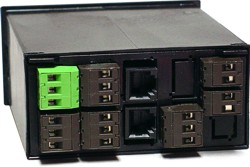
Key Features
- Meets 1/8 DIN Standard.
- Installs from front of panel.
- Short depth behind the panel: only 4" (102 mm) plus connectors.
- Understated 0.157" (4 mm) thick bezel.
- Meets NEMA 4X (IP-65) for high-pressure wawshdon when panel mounted.
- Screw clamps connectors meet VDE / IEC / UL / CSA safety standards.
- Rugged GE Lexan® housing material.
- Safety certified per EN 61010-1.
Dimensions
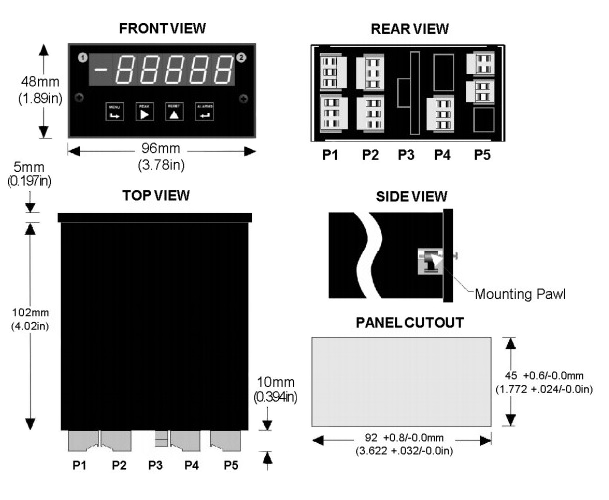
Maximum panel thickness: 4.5 mm (0.18")
Weight of base meter: 210 g (7.4 oz) typical (DPM, counter, timer, 6-digit remote display)
Weight of option boards: 30 g (1.0 oz) typical per board (analog output, relay output, communications)
Tightening Torque - Connectors: Screw terminal connectors: 5 lb-in (0.56 Nm)
Tightening Torque - Pawls: Digital Panel Meter Case Pawls: 5 lb-in (0.56 Nm)
Dimensioned CAD assembly drawings in EPRT, STEP, x_t. dwg, pdf file formats: Laureate-meter-case.zip (zipping prevents browser from opening CAD files as text files).
Panel Mounting
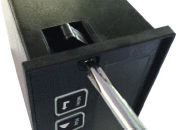 Slide the meter into a 45 x 92 mm 1/8 DIN panel cutout. Ensure that the provided gasket is in place between the front of the panel and the back of the meter bezel.
The meter is secured by two pawls, each held by a screw, as illustrated. Turning each screw counterclockwise extends the pawl outward from the case and behind the panel. Turning each screw clockwise further tightens it against the panel to secure the meter.
Slide the meter into a 45 x 92 mm 1/8 DIN panel cutout. Ensure that the provided gasket is in place between the front of the panel and the back of the meter bezel.
The meter is secured by two pawls, each held by a screw, as illustrated. Turning each screw counterclockwise extends the pawl outward from the case and behind the panel. Turning each screw clockwise further tightens it against the panel to secure the meter.
Turning each screw counterclockwise loosens the pawl and retracts it into its well. This position allows installed meter to be removed from their panel, or new meters to be installed in a panel. Do not remove the screws from their pawls. Doing so would cause the screw and pawl to fall off and likely get lost. Do not overtighten so as not to damage the plastic parts.
| Stopwatch Mode | |
|---|---|
 |
The stopwatch mode is used to time single events to one microsecond resolution between start and stop pulses on the same channel. The width of a single waveshape can be measured by tying the A and B channels together. |
| Timing Process Dynamics | |
 |
The start and stop pulses used for timing can be generated by the dual relay board in a Laureate analog panel meter or digital counter. For instance, the start and stop pulse edges can be created as temperature passes two alarm setpoints, or as temperature cycles in a hysteresis control mode. |
| Rate Based on 1 / Time | |
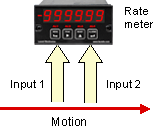 |
The Extended stopwatch meter can be programmed to display highly accurate rate or speed based on time. For example photodetectors on Channels A and B can provide timing pulses as a fast-moving object breaks two light beams, and the meter can then display speed in engineering units such as ft/sec or m/sec. The display will be held until reset by an external control input. |
| Replacing an Oscilloscope with a Laureate Meter | |
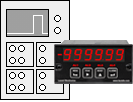 |
An oscilloscope is great for viewing and timing pulses in a lab. However, in fixed installations where digital timing accuracy and control outputs are required, a low-cost Laureate time interval meter will be the instrument of choice. Resolution to 0.2 µs is feasible. |
| Instrumenting a Pulsed Laser System | |
 |
|
| Some of the many possibilities in instrumenting a pulsed laser system with Laureate dual-channel counters: elapsed time, number of pulses, pulse width, pulse separation, duty cycle, and pulse rep rate. | |
IPC
Splashproof Cover
CLB01
RS232 Cable for Meters
CLB02
USB-to-RS232 Adapter Cable
CBL04
RS232 Cable for LT Transmitters
CLB05
USB Data Cable for Meters
CLB06
USB-to-RS485 Adapter Cable
CLB07
USB Programming & Data Cable
CLB08
RS485 Splitter Cable
BKBD
RS485 RJ11 Terminal Block Adapter
Understanding the 1/8 DIN Digital Panel Meter for a 6-Digit Digital Stopwatch and Timer
Introduction
In industrial and laboratory environments, precision and reliability are paramount. Digital panel meters play a crucial role in providing accurate readings and real-time monitoring of various parameters. Among these devices, the 1/8 DIN digital panel meter stands out for its compact size and versatility. When paired with a 6-digit digital stopwatch and timer, this panel meter offers a powerful solution for time-based measurements. But what exactly is a 1/8 DIN digital panel meter, and how does it function in conjunction with a 6-digit digital stopwatch and timer? Let’s explore.
What is a 1/8 DIN Digital Panel Meter?
A 1/8 DIN digital panel meter is a type of instrument used for displaying numerical data in a variety of settings, including industrial, laboratory, and commercial environments. The term "1/8 DIN" refers to the meter's size, which complies with the DIN (Deutsches Institut für Normung) standard for panel-mounted instruments. Specifically, 1/8 DIN panel meters have dimensions of 96mm x 48mm, making them compact and easy to integrate into control panels.
These meters are designed to display various types of measurements such as voltage, current, temperature, pressure, or, in this case, time. The digital aspect signifies that the readings are shown in numerical form on an LED or LCD display, offering precision and ease of reading.
What is a 6-Digit Digital Stopwatch and Timer?
A 6-digit digital stopwatch and timer is an instrument designed to measure and display time intervals with high precision. The six-digit display allows the timer to show time in a format that could range from hours, minutes, and seconds to fractions of a second, depending on the application. This high resolution makes it ideal for applications where precise timing is essential, such as in laboratories, testing facilities, or industrial processes.
These stopwatches and timers are often used in scenarios that require strict time tracking, like testing the response time of systems, measuring elapsed time during production processes, or monitoring time intervals in research experiments.
The Integration of 1/8 DIN Digital Panel Meter with a 6-Digit Digital Stopwatch and Timer
When these two devices are combined, they create a powerful tool for time measurement and monitoring. The 1/8 DIN digital panel meter acts as the display and control interface for the 6-digit digital stopwatch and timer. This integration allows users to view real-time data and control time-related functions directly from the panel meter.
Key Features and Benefits:
-
Compact Design: The 1/8 DIN size allows for easy integration into existing control panels without requiring significant space, making it ideal for environments where space is at a premium.
-
High Precision: The 6-digit display provides high-resolution time measurement, crucial for applications where even a fraction of a second can make a difference.
-
Versatility: This setup can be used across a variety of industries, from manufacturing and quality control to research and development, providing reliable and precise timing solutions.
-
Ease of Use: The digital interface allows for easy reading and operation, ensuring that users can quickly set, start, stop, and reset the timer as needed.
-
Customization: Many 1/8 DIN digital panel meters offer programmable options, allowing users to customize the display and functionality to match their specific requirements.
Applications of 1/8 DIN Digital Panel Meter with Stopwatch and Timer
The combination of a 1/8 DIN digital panel meter with a 6-digit digital stopwatch and timer is widely used in various applications, including:
- Manufacturing Processes: To monitor and control the duration of specific production processes, ensuring consistency and quality.
- Testing and Quality Control: For timing tests and experiments where precise time measurement is crucial.
- Automation Systems: To integrate time-based controls in automated systems, ensuring synchronized operations.
- Research Laboratories: For accurate measurement of time intervals during experiments and data collection.
Conclusion
The 1/8 DIN digital panel meter combined with a 6-digit digital stopwatch and timer is a versatile and precise tool for time measurement and monitoring. Its compact design, ease of integration, and high precision make it an essential component in various industrial and laboratory applications. Whether you're looking to enhance your manufacturing process, conduct detailed testing, or ensure accurate time tracking in research, this combination offers a reliable solution to meet your needs.
Where is a 1/8 DIN Digital Panel Meter for a 6-Digit Digital Stopwatch and Timer Used?
A 1/8 DIN digital panel meter designed for a 6-digit digital stopwatch and timer is a specialized device commonly used in various industrial and commercial settings. Its primary function is to display time measurements with high precision, making it a crucial component in processes where accurate timing is essential. Here's an overview of where and how this device is typically used:
1. Manufacturing and Production Lines
In manufacturing environments, timing is critical for ensuring the efficiency and accuracy of production processes. A 1/8 DIN digital panel meter integrated with a stopwatch and timer is often used to:
- Monitor cycle times: It helps in tracking the time taken for each step in the production process, ensuring that each cycle is completed within the desired timeframe.
- Control machine operations: The panel meter can be connected to machinery to start or stop operations based on preset time intervals, improving automation and reducing human error.
- Quality control: By timing certain processes, the panel meter ensures that components or products meet quality standards, avoiding under- or over-processing.
2. Laboratory Testing and Calibration
In laboratory settings, precise time measurement is crucial for experiments, testing, and calibration tasks. The 1/8 DIN digital panel meter is often used to:
- Record experiment durations: Accurate timing is essential in experiments, especially when dealing with chemical reactions or physical processes that require specific time frames.
- Calibration of instruments: It helps in the calibration of other timing devices or instruments, ensuring that they operate within the required specifications.
3. Automation Systems
Automation systems in various industries, including manufacturing, pharmaceuticals, and food processing, rely heavily on timing for efficient operations. The digital panel meter is used to:
- Synchronize processes: By providing accurate time data, it ensures that different parts of an automated system operate in sync, preventing delays or overlaps that could lead to inefficiencies or defects.
- Control batch processing: In industries where products are created in batches, the timer can manage the duration of each batch, ensuring consistency in quality and output.
4. Energy Management and Utilities
In energy management systems, timing is crucial for monitoring and controlling energy usage. The panel meter is often used to:
- Monitor load durations: It can track the duration for which specific loads are active, helping in optimizing energy consumption and reducing costs.
- Control timed operations: In utilities, such as water treatment plants, the meter can be used to control operations that need to be performed at specific intervals, ensuring efficiency and compliance with regulations.
5. Transportation and Logistics
In the transportation and logistics sectors, timing is essential for tracking and managing the movement of goods and vehicles. The 1/8 DIN digital panel meter is used to:
- Monitor transit times: It helps in recording the time taken for goods to move from one point to another, ensuring that delivery schedules are met.
- Control timed dispatches: The timer can be used to manage the timing of vehicle dispatches, ensuring that they are spread out evenly to avoid congestion and improve efficiency.
6. Healthcare and Medical Equipment
In healthcare settings, precise timing is critical for various procedures and the operation of medical equipment. The digital panel meter is used to:
- Time medical procedures: It can be used in devices that require accurate timing, such as infusion pumps, where the duration of medication delivery must be closely monitored.
- Monitor patient treatments: In certain treatments, the duration must be controlled to ensure efficacy and safety, making the panel meter an essential tool in the process.
Conclusion
A 1/8 DIN digital panel meter for a 6-digit digital stopwatch and timer is a versatile device used across multiple industries. Its ability to provide accurate and reliable time measurement makes it indispensable in environments where timing is critical to operations, safety, and quality control. Whether in manufacturing, laboratories, automation systems, energy management, transportation, or healthcare, this panel meter ensures that processes run smoothly, efficiently, and within the required time constraints.
Less Information.








